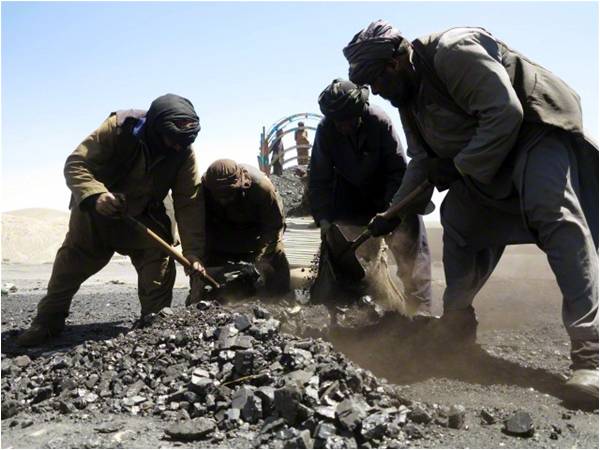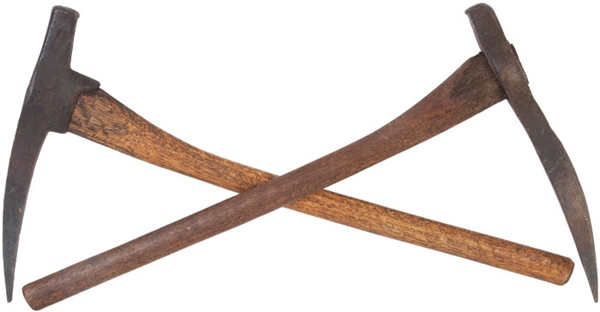
Five coal miners who died when a mine caved in in Orakzai Agency were laid to rest in their home town of Shangla on March 13.
Akhtar, Saddam Hussain, Ahmad Khan and Ahmad Hussain, all young men aged between 18 and 23 years, were laid to rest in their ancestral graveyard in Borshat Kozkana, while young Zakir was buried in Banjar village.
On March 12, nine miners were killed and many others injured when a coalmine located in Doli area of Orakzai Agency collapsed because of an explosion, reportedly caused by accumulation of gases. “Six workers from our district died in the accident, while six were injured with serious burns,” said the Shangla’s district nazim Niaz Ahmad Khan, who accompanied the men to the Pakistan Institute of Medical Sciences (PIMS) in Islamabad.
The political administration in Orakzai Agency linked the incident to the ongoing rains, but miners accompanying the dead bodies claim the explosion occurred due to gas accumulation.
Shangla, a backward district of Khyber Pakhtunkhwa, is home to a large number of coal miners. Most of the district is rough terrain. Because of a lack of cultivatable land, most of which is owned by affluent families, the poor take up the risky mining jobs. Such villages as Nawekalay, Turban, Kanra, Rinyal, Dairan, Aluch, Kanra and Borshat Kozkana are famous for their coalminers. Minders from Shangla district go to Hangu, Dara Adam Khel, Orakzai Agency, Kurram Agency, Balochistan and Sindh for work.
“Almost 80% of the population of the district is associated with coalmining,” says Shangla-based journalist Khalid Khan. “Immense poverty, illiteracy, lack of civic opportunities and the government’s ignorance compel them to adopt this dangerous occupation.”
According to Khalid, dead bodies arriving after fatal mining accidents is now a routine matter in the district of Shangla. Many die when mines collapse, and others inhale poisonous gases. “The profession of mining has been passed on to these people by their ancestors,” he says. “Even if a father becomes a victim of a coalmine accident, his sons become miners because they know no other occupation.”
Contractors find cheap workforce in the district, and most mining companies do not register their workers. They are given no healthcare facilities.

At least 23 miners from Shangla died in 2015 while at work in the tribal areas, Khyber Pakhtunkhwa, Sindh and Balochistan. In 2016, 14 miners from the district have died in four different accidents so far.
In March 2011, 37 miners from Shangla died in a single accident in Balochistan.
On September 29, 2010 militants abducted 32 coalminers from Kala Khel, a semi-tribal area near Peshawar. The abducted miners belonged to Basiya, Belababa and Shahpur villages of Shangla. Fourteen of them escaped, and 18 are still missing. Their families are optimistic that they are alive and will return.
One family in Nawekalay village in Alpuri tehsil lost all its male members to coalmine the coalmine accident in Balochistan. “My father and brothers died in the Balochistan accident. Now, with no earning hands, we are forced to live on alms and charity,” Shahida Bibi told me.
Contractors usually hire the children of workers who die in mining accidents. Some of them are as young as eight, and are taken to the mines to collect small pieces of coal outside.
Munir Khan, a miner from Alpuri, told me workers were paid Rs 2,000 to Rs 2,500 per day. No other occupation available to them would match that salary. “But working in a coalmine is not an easy job. There are no machines. Extraction, cutting, loading and transportation are all done by hand.”
Most miners die because of poor rescue operations, according to Muhammad Rashad Khan, a provincial lawmaker from Shangla who belongs to Pakistan Muslim League-Nawaz. “No one cares about the miners,” he says, “neither the government nor the mining companies. Most of such cases are not reported by the media.” Rashad says 70% of coalmines in Pakistan are illegal.
“There are 19,000 registered orphans of mineworkers in Malakand division,” according to the lawmaker. “That shows how risky the job is.” The victims’ families are not paid any compensation by the mining companies, he says, and when they do, the process takes up to two years. Rashad says the federal government should form a commission to identify dangerous mines.
Dr Fazal Rabi, who used to work in the district headquarters hospital, said miners develop serious health issues after three years of work. “A majority of miners contract occupational diseases like pneumoconiosis, dermatitis, Asthma, Tuberculosis and weak eyesight.” Many of these diseases could be avoided with protective equipment and measures, but the doctor say even the miners do not care too much about their health. “They only consult a doctor when their diseases make it impossible for them to do their jobs.”
Another provincial lawmaker Abdul Munim Khan, wo belongs to the ruling Pakistan Tehrik-e-Insaf, said some local politicians had deliberately kept the district illiterate. “Before the PTI came to power in the province, there were only 82 schools for boys in my constituency. We have approved 16 new schools in the area,” he says. “Only education can change the fate of the people of Shangla.”
Anisa Zeb Tahirkhel, the minister for Labor and Minerals in Khyber Pakhtunkhwa, said there was a need to probe the March 12 accident and demanded stern punishment for those who are responsible. She said some mining companies used outdated equipment, which was one reason behind these accidents. Orakzai Agency is part of the tribal areas outside her jurisdiction, but she said there were lessons to be learned for mining safety in her province too. “I am going to improve the mining safety laws in Khyber Pakhtunkhwa, and the ministry will provide safety training to miners.”
Tahir Ali is an Islamabad-based journalist
Twitter: @tahirafghan
Akhtar, Saddam Hussain, Ahmad Khan and Ahmad Hussain, all young men aged between 18 and 23 years, were laid to rest in their ancestral graveyard in Borshat Kozkana, while young Zakir was buried in Banjar village.
On March 12, nine miners were killed and many others injured when a coalmine located in Doli area of Orakzai Agency collapsed because of an explosion, reportedly caused by accumulation of gases. “Six workers from our district died in the accident, while six were injured with serious burns,” said the Shangla’s district nazim Niaz Ahmad Khan, who accompanied the men to the Pakistan Institute of Medical Sciences (PIMS) in Islamabad.
The political administration in Orakzai Agency linked the incident to the ongoing rains, but miners accompanying the dead bodies claim the explosion occurred due to gas accumulation.
Shangla, a backward district of Khyber Pakhtunkhwa, is home to a large number of coal miners. Most of the district is rough terrain. Because of a lack of cultivatable land, most of which is owned by affluent families, the poor take up the risky mining jobs. Such villages as Nawekalay, Turban, Kanra, Rinyal, Dairan, Aluch, Kanra and Borshat Kozkana are famous for their coalminers. Minders from Shangla district go to Hangu, Dara Adam Khel, Orakzai Agency, Kurram Agency, Balochistan and Sindh for work.
"My father and all my brothers died in a coalmine accident"
“Almost 80% of the population of the district is associated with coalmining,” says Shangla-based journalist Khalid Khan. “Immense poverty, illiteracy, lack of civic opportunities and the government’s ignorance compel them to adopt this dangerous occupation.”
According to Khalid, dead bodies arriving after fatal mining accidents is now a routine matter in the district of Shangla. Many die when mines collapse, and others inhale poisonous gases. “The profession of mining has been passed on to these people by their ancestors,” he says. “Even if a father becomes a victim of a coalmine accident, his sons become miners because they know no other occupation.”
Contractors find cheap workforce in the district, and most mining companies do not register their workers. They are given no healthcare facilities.

At least 23 miners from Shangla died in 2015 while at work in the tribal areas, Khyber Pakhtunkhwa, Sindh and Balochistan. In 2016, 14 miners from the district have died in four different accidents so far.
In March 2011, 37 miners from Shangla died in a single accident in Balochistan.
On September 29, 2010 militants abducted 32 coalminers from Kala Khel, a semi-tribal area near Peshawar. The abducted miners belonged to Basiya, Belababa and Shahpur villages of Shangla. Fourteen of them escaped, and 18 are still missing. Their families are optimistic that they are alive and will return.
One family in Nawekalay village in Alpuri tehsil lost all its male members to coalmine the coalmine accident in Balochistan. “My father and brothers died in the Balochistan accident. Now, with no earning hands, we are forced to live on alms and charity,” Shahida Bibi told me.
Contractors usually hire the children of workers who die in mining accidents. Some of them are as young as eight, and are taken to the mines to collect small pieces of coal outside.
Munir Khan, a miner from Alpuri, told me workers were paid Rs 2,000 to Rs 2,500 per day. No other occupation available to them would match that salary. “But working in a coalmine is not an easy job. There are no machines. Extraction, cutting, loading and transportation are all done by hand.”
Most miners die because of poor rescue operations, according to Muhammad Rashad Khan, a provincial lawmaker from Shangla who belongs to Pakistan Muslim League-Nawaz. “No one cares about the miners,” he says, “neither the government nor the mining companies. Most of such cases are not reported by the media.” Rashad says 70% of coalmines in Pakistan are illegal.
“There are 19,000 registered orphans of mineworkers in Malakand division,” according to the lawmaker. “That shows how risky the job is.” The victims’ families are not paid any compensation by the mining companies, he says, and when they do, the process takes up to two years. Rashad says the federal government should form a commission to identify dangerous mines.
Dr Fazal Rabi, who used to work in the district headquarters hospital, said miners develop serious health issues after three years of work. “A majority of miners contract occupational diseases like pneumoconiosis, dermatitis, Asthma, Tuberculosis and weak eyesight.” Many of these diseases could be avoided with protective equipment and measures, but the doctor say even the miners do not care too much about their health. “They only consult a doctor when their diseases make it impossible for them to do their jobs.”
Another provincial lawmaker Abdul Munim Khan, wo belongs to the ruling Pakistan Tehrik-e-Insaf, said some local politicians had deliberately kept the district illiterate. “Before the PTI came to power in the province, there were only 82 schools for boys in my constituency. We have approved 16 new schools in the area,” he says. “Only education can change the fate of the people of Shangla.”
Anisa Zeb Tahirkhel, the minister for Labor and Minerals in Khyber Pakhtunkhwa, said there was a need to probe the March 12 accident and demanded stern punishment for those who are responsible. She said some mining companies used outdated equipment, which was one reason behind these accidents. Orakzai Agency is part of the tribal areas outside her jurisdiction, but she said there were lessons to be learned for mining safety in her province too. “I am going to improve the mining safety laws in Khyber Pakhtunkhwa, and the ministry will provide safety training to miners.”
Tahir Ali is an Islamabad-based journalist
Twitter: @tahirafghan

